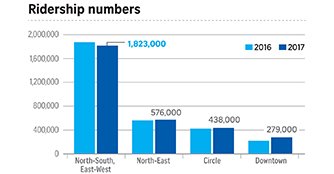Rare ridership dip on North-South, East-West MRT lines
19 Mar 2018|3,903 views
The North-South and East-West MRT lines - Singapore's oldest and most heavily used rail systems - posted a rare dip in ridership last year. According to the Land Transport Authority (LTA), average daily ridership on the two lines was 1.823 million last year, 3.1% lower than in 2016. This shrinkage reversed an almost continuous upward trend seen since the two lines opened 30 years ago.

Reasons for the decline are not clear, although transport watchers have cited reasons such as the growing popularity of private-hire cars, the series of service disruptions (especially on the North-South Line) last year, and cannibalisation from newer rail lines.
In total, average MRT ridership crept up by 0.8% to 3.116 million a day, despite the network growing by 16% to 207km owing to the Tuas West Extension and Downtown Line 3, which opened in June and October respectively.
National University of Singapore Transport Researcher Lee Der-Horng said, "A 16% growth in network is not insignificant. So, more will be needed to be done to promote a 'car-lite' Singapore."
Professor Lee said some commuters may have shifted from the North-South and East-West lines to the Downtown Line. In fact, the 59,000 drop in rides for the two oldest lines equals the 59,000 increase on the Downtown Line.
This, he said, was attributable to the geographical coverage of the new line, but 'the series of hiccups' on the older lines 'may also play a part'.

And despite modification works completed seven years ago to ease congestion at the Jurong East interchange between the North-South and East-West lines, commuters are still complaining about the choke point.
"I know they've tried their best, but it's still a bit of a mess there during the morning and evening peaks," said student Kyle Malinda-White, 25.
Meanwhile, total public transport ridership (including buses and LRT) grew by 0.7% to 7.264 million - the smallest growth on record. The LTA, however, said public transport has been gaining ground as far as peak-period travel goes.
It said trains and buses now account for 62% of travel during the morning and evening rush hours, up from 58% four years ago, and 54% eight years ago.
It added that the share of taxis, and of late, private-hire cars, has remained unchanged at 5% during these periods. The LTA's figures are from the Household Interview Travel Survey, which found that total daily journeys rose from 11 million in 2008 to 12.5 million in 2012. It said the 2016-17 figure will be available only later this year.
The North-South and East-West MRT lines - Singapore's oldest and most heavily used rail systems - posted a rare dip in ridership last year. According to the Land Transport Authority (LTA), average daily ridership on the two lines was 1.823 million last year, 3.1% lower than in 2016. This shrinkage reversed an almost continuous upward trend seen since the two lines opened 30 years ago.

Reasons for the decline are not clear, although transport watchers have cited reasons such as the growing popularity of private-hire cars, the series of service disruptions (especially on the North-South Line) last year, and cannibalisation from newer rail lines.
In total, average MRT ridership crept up by 0.8% to 3.116 million a day, despite the network growing by 16% to 207km owing to the Tuas West Extension and Downtown Line 3, which opened in June and October respectively.
National University of Singapore Transport Researcher Lee Der-Horng said, "A 16% growth in network is not insignificant. So, more will be needed to be done to promote a 'car-lite' Singapore."
Professor Lee said some commuters may have shifted from the North-South and East-West lines to the Downtown Line. In fact, the 59,000 drop in rides for the two oldest lines equals the 59,000 increase on the Downtown Line.
This, he said, was attributable to the geographical coverage of the new line, but 'the series of hiccups' on the older lines 'may also play a part'.

And despite modification works completed seven years ago to ease congestion at the Jurong East interchange between the North-South and East-West lines, commuters are still complaining about the choke point.
"I know they've tried their best, but it's still a bit of a mess there during the morning and evening peaks," said student Kyle Malinda-White, 25.
Meanwhile, total public transport ridership (including buses and LRT) grew by 0.7% to 7.264 million - the smallest growth on record. The LTA, however, said public transport has been gaining ground as far as peak-period travel goes.
It said trains and buses now account for 62% of travel during the morning and evening rush hours, up from 58% four years ago, and 54% eight years ago.
It added that the share of taxis, and of late, private-hire cars, has remained unchanged at 5% during these periods. The LTA's figures are from the Household Interview Travel Survey, which found that total daily journeys rose from 11 million in 2008 to 12.5 million in 2012. It said the 2016-17 figure will be available only later this year.
Latest COE Prices
November 2025 | 1st BIDDING
NEXT TENDER: 19 Nov 2025
CAT A$110,002
CAT B$115,001
CAT C$76,000
CAT E$121,010
View Full Results Thank You For Your Subscription.



















